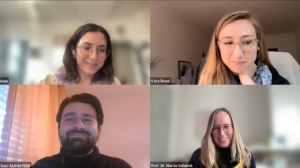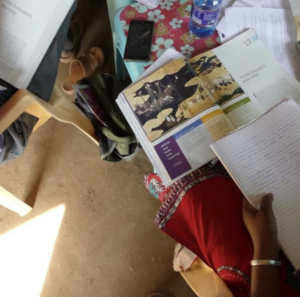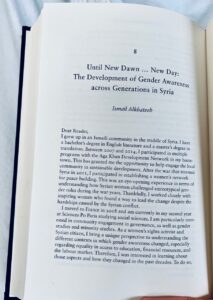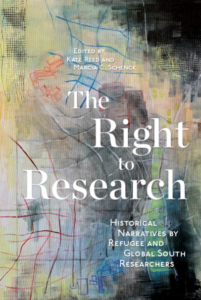Displaced people are rarely perceived as researchers in their own right. This conversation, which takes place between historians with and without forced migration backgrounds who work together as co-authors, editors, and contributors, explores what it means to become a researcher and what some of the challenges facing displaced scholars are.
Refugees and displaced people rarely figure as historical actors, and almost never as historical narrators. We often assume a person residing in a refugee camp, lacking funding, training, social networks, and other material resources that enable the research and writing of academic history, cannot be a historian because a historian cannot be a person residing in a refugee camp. The anthology The Right to Research: Historical Narratives by Refugee and Global South Researchers, published in 2023 with McGill-Queen’s University Press in their forced migration studies series, disrupts this tautology by featuring nine works by refugee and host-community researchers from across Africa, Europe, and the Middle East. Identifying the intrinsic challenges of making space for diverse voices within a research framework and infrastructure that is inherently unequal, this edited volume offers a critical reflection on what history means, who narrates it, and what happens when those long excluded from authorship bring their knowledge and perspectives to bear. The book is divided into three parts, the first focusing on border crossing, the second on cultures in motion and the third on identity and (un)belonging. Chapters address topics such as education in Kakuma Refugee Camp, the political power of hip-hop in Rwanda, women migrants to Yemen, and the development of photojournalism in Kurdistan, and gender awareness in Syria. Each contribution is prefaced by a letter to the reader.
Today, we share with you a part of a longer conversation between Canada, the US, France, and Germany about how the book came to be, its intended readership, and what claim it tries to make. We are Irem Karabağ, project writer at The Local Engagement Refugee Research Network (LERRN), Ismail Alkhateeb, contributor to, and Kate Reed and Marcia C. Schenck, editors of, the anthology. We have preserved the conversational style in the text below because we would also like to invite you—our readers—into the dialogue! What you have in front of you are excerpts of a cleaned and edited transcript, which renders visible the conditions of production of our scholarship—an issue that is central to the book, as well.

Conversation partners Irem Karabağ, Ismail Alkhateeb, Kate Reed and Marcia C. Schenck.
Genesis of our Collaborative Project
Marcia C. Schenck: At the heart of the origin story of the anthology lies the Global History Dialogues Project, a course I developed in 2019 that teaches oral history research methodology and project design, implementation, and presentation to learners from across the world. Kate was a teaching assistant and program manager on the course and Ismail was a student. To understand the idea for the project, we must go even farther back. In 2016, I first went to Kakuma refugee camp in Kenya. I was a teaching assistant at the time for a course taught by professor Jeremy Adelman at Princeton university, a straight up global history course called History of the World 1300 to the present. I was teaching this course to my students. And we started talking about the absence of themes such as forced migration. The absence of the theme, but also the absence of voices of scholars with a displaced background in the production of what we were reading and learning about. That got us thinking about designing a course that could specifically set out to address that silencing of voices by providing the training in a methodology that is accessible to everybody no matter where they’re placed, which is oral history; providing training in analysis of sources; and providing training also in storytelling and narration. Therefore, I wanted to offer the tools to actually focus on the students’ own research questions and do the research, develop the archives that they need to answer their question and then tell the story to the world, whether that’s during a student conference, or publishing it as a blog post, or even taking it further. The contributors to this anthology have taken their research even further to develop it into a book contribution.

Studying global history in Kakuma Refugee Camp in 2016.
Refugees as Actors and Narrators of History
Ismail Alkhateeb: The book is trying to tackle that for a long time, refugees or the displaced were treated as objects of study and regarded in isolation of the societies in which they live.
There’s no consideration of the heritage that they are bringing along to their host communities. The question here is how to decolonize this experience; how to realize the process of understanding the people’s experience and what they’re bringing to their host communities. And part of it is to give a role to first-hand experiences and provide people with a platform to narrate their version of history. A history not only depending on incidents, on certain reports, but also to add the human feelings and to ask for empathy in the narrative. This is what makes the narrative inclusive. We are trying to have inclusive history at the end of the day. Another challenge that the book was trying to tackle is that people who consider themselves as refugees or displaced are often being portrayed as victims in Western media, regardless of their experience. … This book is providing a chance to be the narrator and to add a critical contribution to the narrative.
Irem Karabağ: Yeah, thank you for that. … there’s definitely that sense of switch, where refugees and displaced people are acting rather than being acted upon. … I truly appreciate that. … all of you address the reader in the beginning of your chapters [see Image 0.3] … You start with saying, we know our positionalities, we know where we come from, and here’s what we try to do. Can you tell me more about your unconventional methods?

Ismail Alkhateeb’s letter to the reader prefacing his contribution in the anthology.
The Conditions of Production
Marcia C. Schenck: One of the things that is really important to us in this book is to make “the conditions of production,” and here I’m using Michel-Rolph Trouillot’s term, as visible to the reader as possible. Because often when we read conventional edited volumes, the process of research has disappeared. We see the end product. But given that we have an amazing group of contributors who have resided in so many different places, among them France, Syria, Iraqi Kurdistan, Ruanda, Kenya, Ethiopia, Yemen, and Saudi Arabia, we have lots of different traditions of storytelling; different topics that come to the fore; and different conditions of production mark the process of scholarship. Some of our contributors reside in refugee camps and depended, especially during the pandemic, on their cell phones for writing up things. Others have had access to learning centers, have had their own computers, have had access to universities. So very different production conditions. And we wanted to really make that transparent. One of the ways in which we wanted to allow for that is to have these letters-to-the-reader where we invited the contributors, and also did that ourselves, to comment on where we come from vis-a-vis the project, the book, the research, how we actually went about doing the research, what our impressions are, and also what we would like the reader to take away.
This also leads to the other emphasis that we have in the book, which is on dialogue. We say, research is a form of dialogue, multilayered dialogue. It’s the researcher with the oral history interviewees; it’s the researcher with other archival sources; it’s the researcher with the other researchers in the Global History Dialogues Project, with the professors, with the teaching assistants, with colleagues. And then ultimately with the audience, and in this case, the audience is the reader of the anthology. We thought by addressing the reader and inviting them into the conversation as much as we could, we might entice them to engage. It would be great to hear form some of our readers. I will put on a seminar in the fall semester at the University of Potsdam, where my students will engage with the book and write letters in return to the authors.
Addressing our Audience
Irem Karabağ: Kate, maybe would you like to expand more on this idea of accessibility to a wide audience?
Kate Reed: The question of audience, who the book is for, which is, in an ideal world, everyone. One of the questions that we thought a lot about together, was how to bring these stories that contributors had written, both, the stories of the people they interviewed and then also their interpretations and framing of those stories, to a wider public. … For instance, Muna Omar, one of our contributors, writes about the process of translation of the interviews she did and her decision to leave really long sections of the interviewees in her text, which is somewhat unconventional and actually something that some of our reviewers said, well, maybe you should cut down on the quotes and have more of the author’s voice. She was firm and said, no, it’s really important to me that those voices are preserved intact, to have those fragments of their experiences preserved, in the words that they chose to use, and in the way that they chose to express them to me. She was able to explain that also in the introduction to her chapter. Making the construction of the text transparent is also in some way an invitation to readers to engage with that and ask perhaps their own questions of their context and what it would look like for them to engage in similar processes of inquiry and research in their own local environments. We’re really hoping that this book does serve as an invitation – to students in particular, to student researchers, to people who maybe aren’t sure that they’re historians, but are interested in historical questions – to think about all of the different ways that they can engage with their local contexts as researchers, as historians, and to think about how their position in those contexts shapes the kinds of questions they ask and how they come to answer them.

Cover of the Right to Research
Challenges
Kate Reed: I would speak specifically to the conclusion of the book, which we wrote all of us together with 11 co-authors. Thinking about the book as a whole, it is bringing all of these voices together, but everyone has their autonomy within their chapter.
But then in the conclusion … we had disagreements about who the audience of our work should be; we had disagreements about the best way to present it; and disagreements about is it more important to publish historical scholarship for an academic audience or to think more widely about community facing scholarship. … Those things aren’t mutually exclusive, but it does involve a selection of priorities. … Those conversations that resulted in the conclusion that we all wrote together and thinking, okay, how do we represent in writing in a linear sort of narrative way all these tensions and points of agreement and points of disagreement. For me, that was really challenging, but also generative and forced me to reflect critically on my own practice of historical scholarship as someone who works mostly in a traditional way with archives and textual sources and writing as one author to think, okay, what does this collaborative form of historical scholarship mean? What kinds of opportunities and challenges does that pose for thinking about history as a discipline? And for expanding, pushing at the edges? We’re still inside history, we’re still trying to be included, but pushing a little bit and saying, what if we took this a step further? What could we see from this edge of history as a discipline that challenges some of our assumptions?
Lessons Learned
Ismail Alkhateeb: This experience was both humbling and thought provoking at the same time. I would say to anyone who’s coming from a migrant background such as myself, I previously thought that when I was framed as a migrant, I could not really act. But this experience has proven this assumption wrong, for everyone to see. There are people who do not agree with the conventional process of research but like to take a look at their history around them and to listen and try to document. I would encourage them and ask them to prepare to try to mix a lot of methods together, like photos and pieces of paper. All these things can be worth keeping as an archive, along with the living archive, meaning us as human beings.
Author information:
Ismail Alkhateeb, originally from Syria, resides in France where he works as translator and in civil society development, program evaluation and project management.
Irem Karabağ is project writer at The Local Engagement Refugee Research Network (LERRN) and a PhD student at York University in Canada.
Kate Reed is a PhD student in Latin American history at the University of Chicago.
Marcia C. Schenck is Professor of Global History at Potsdam University and Junior Fellow at the Historische Kolleg in Munich.
